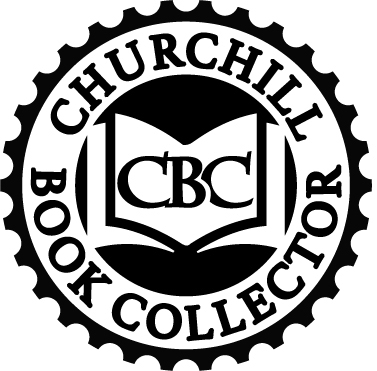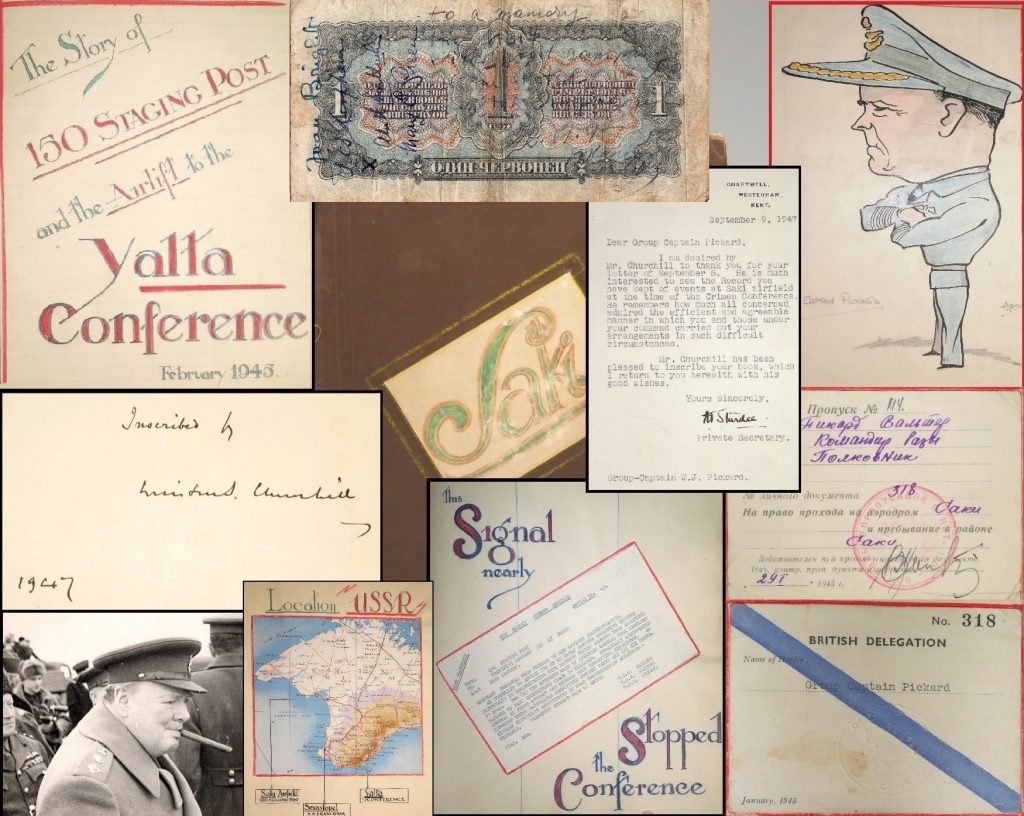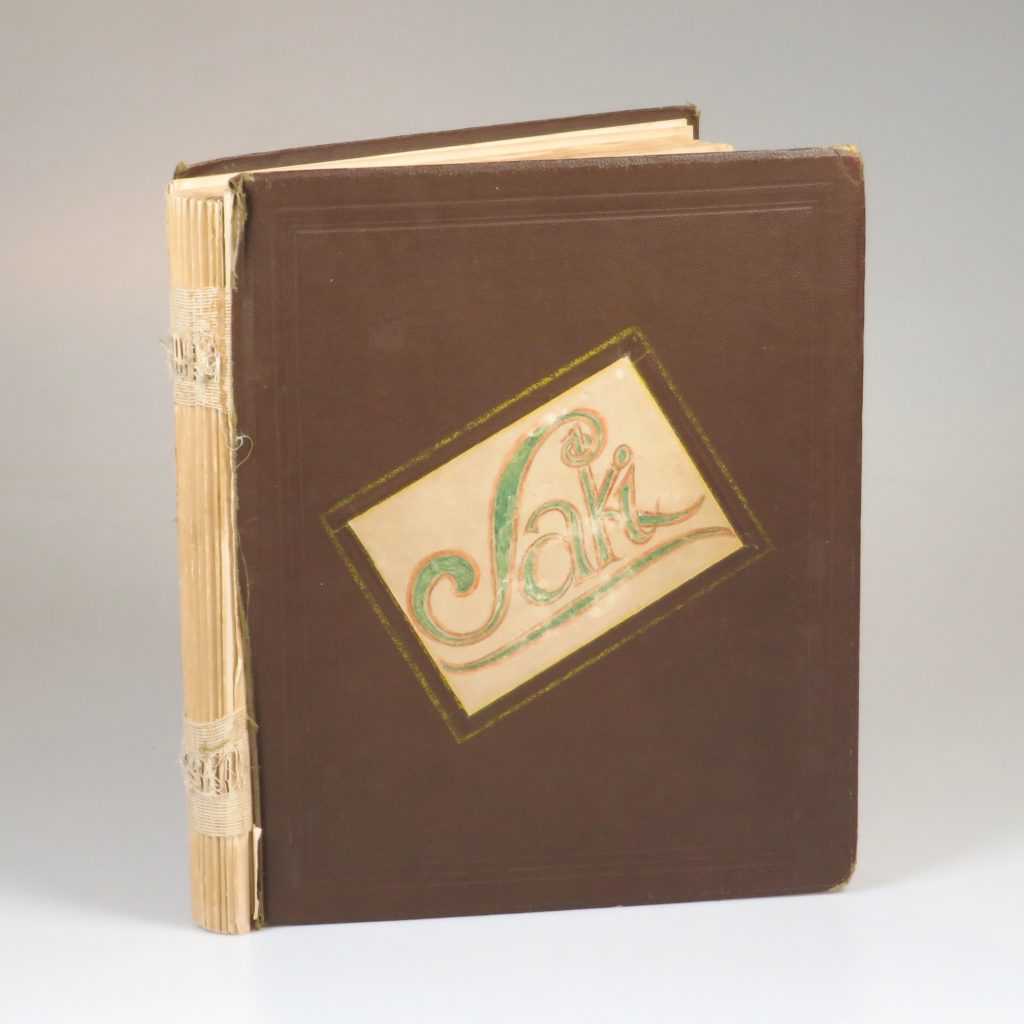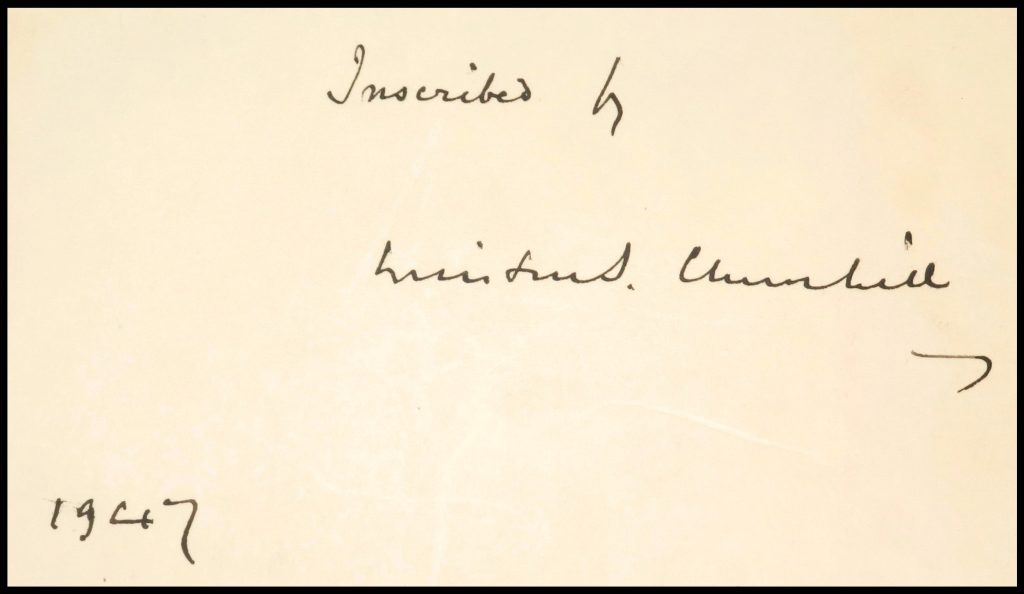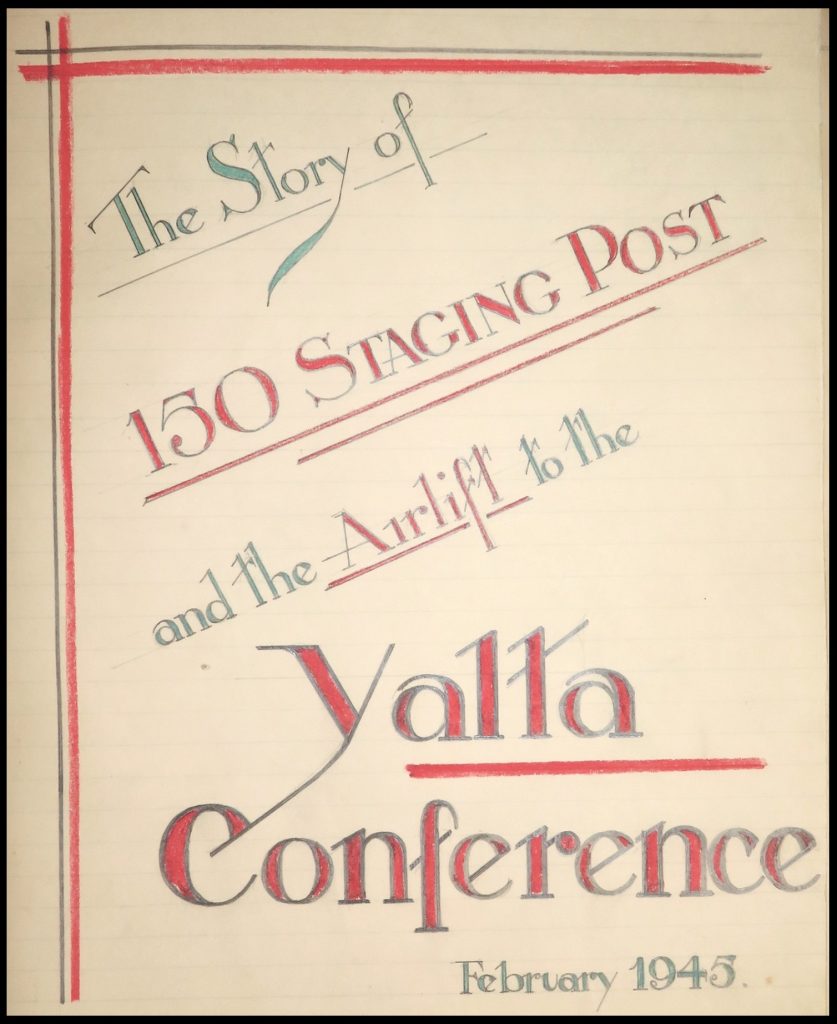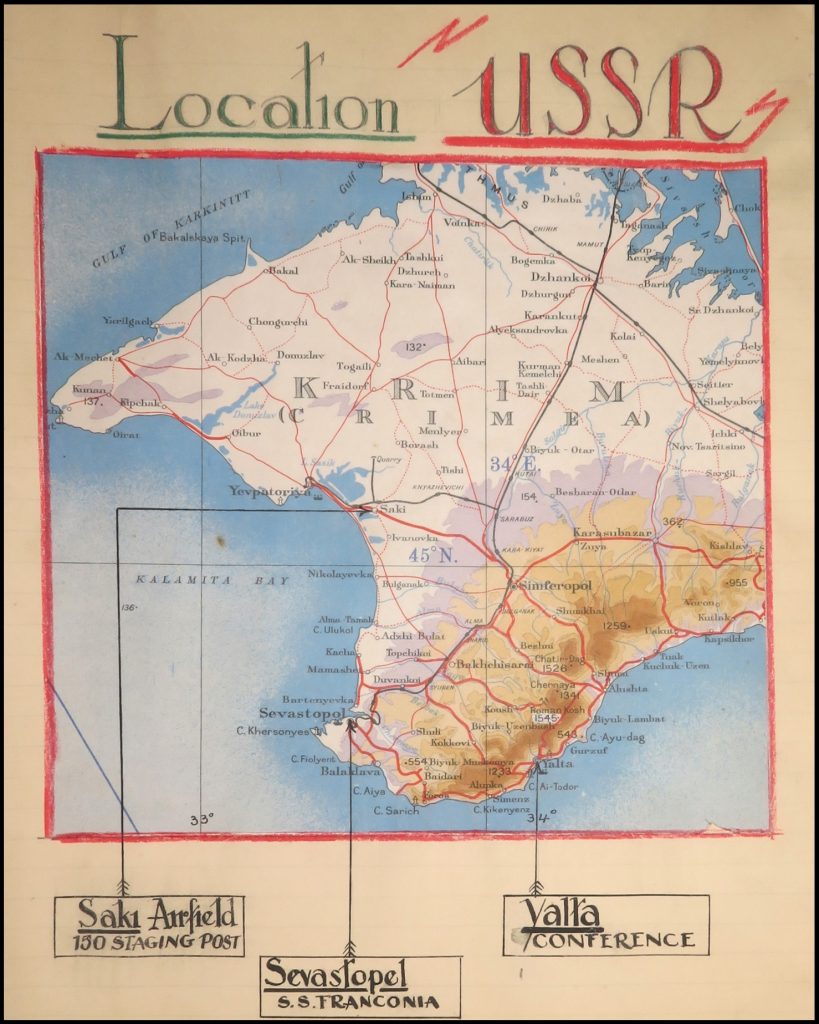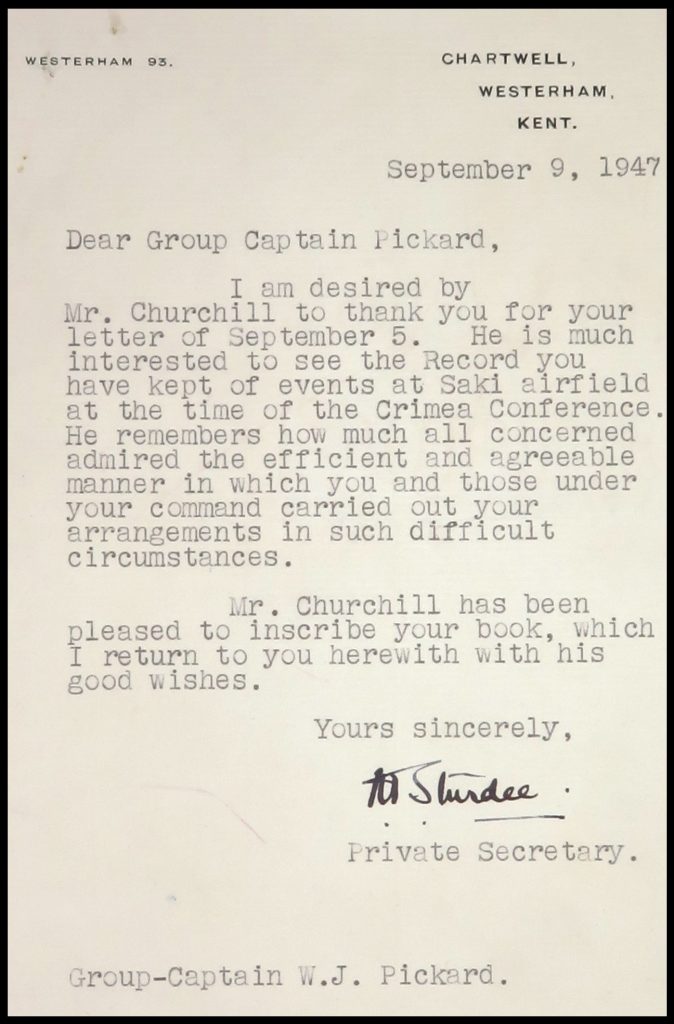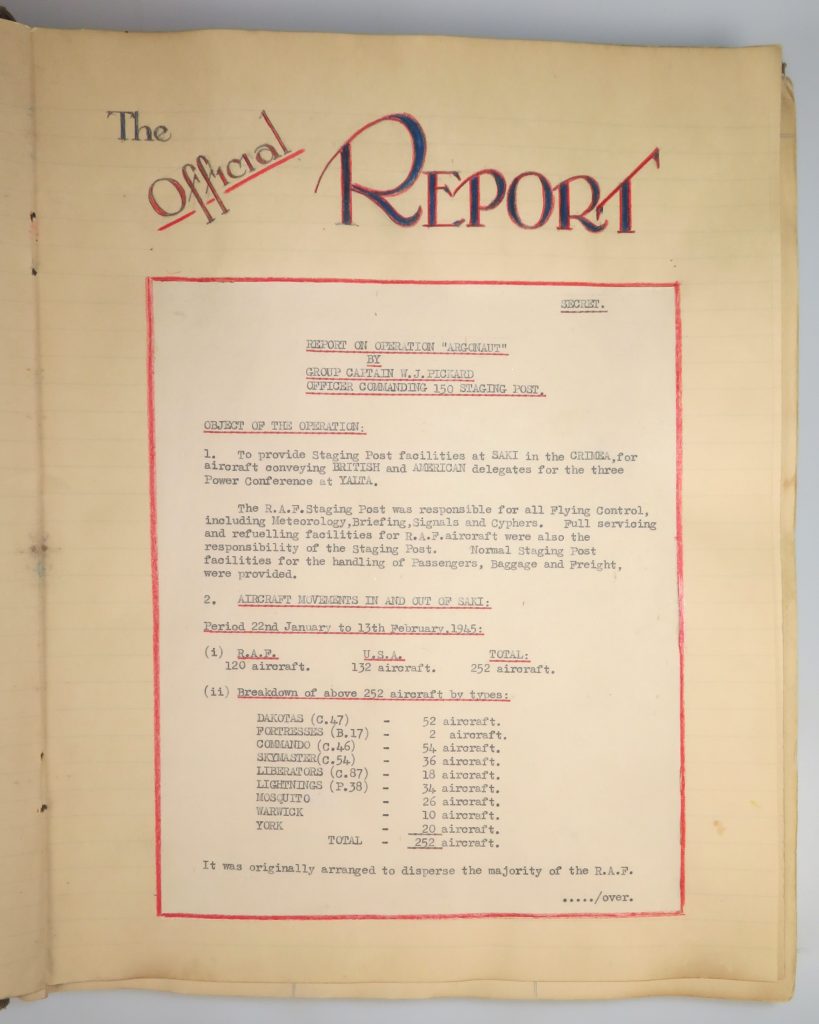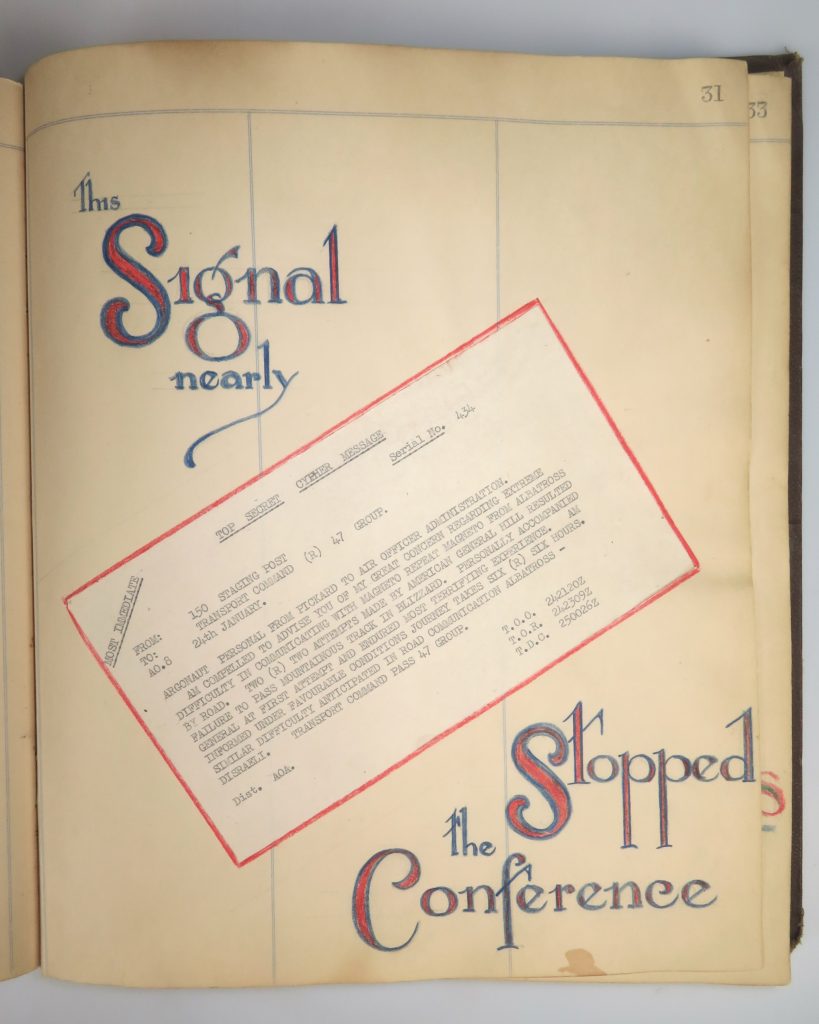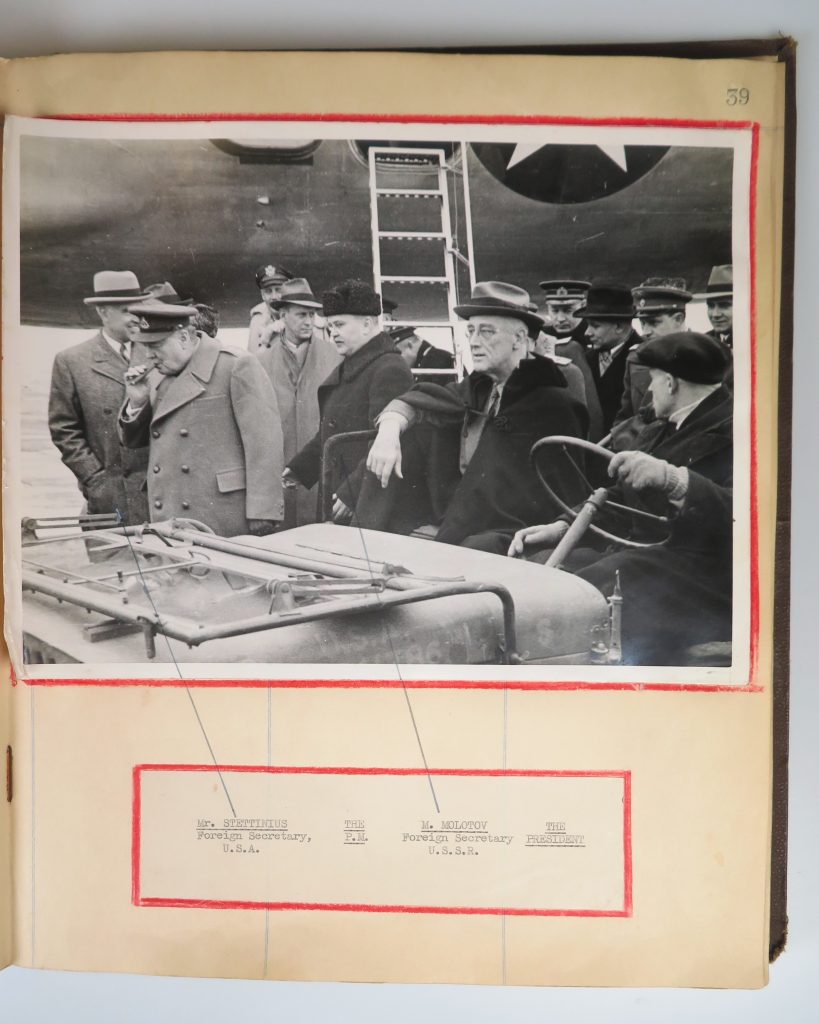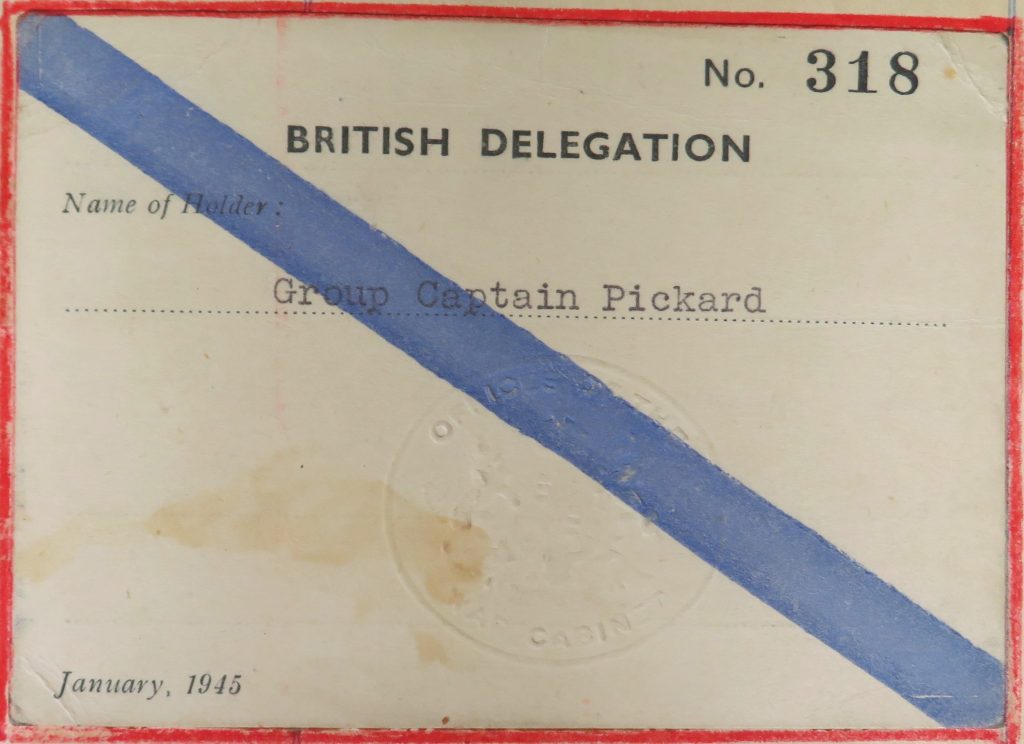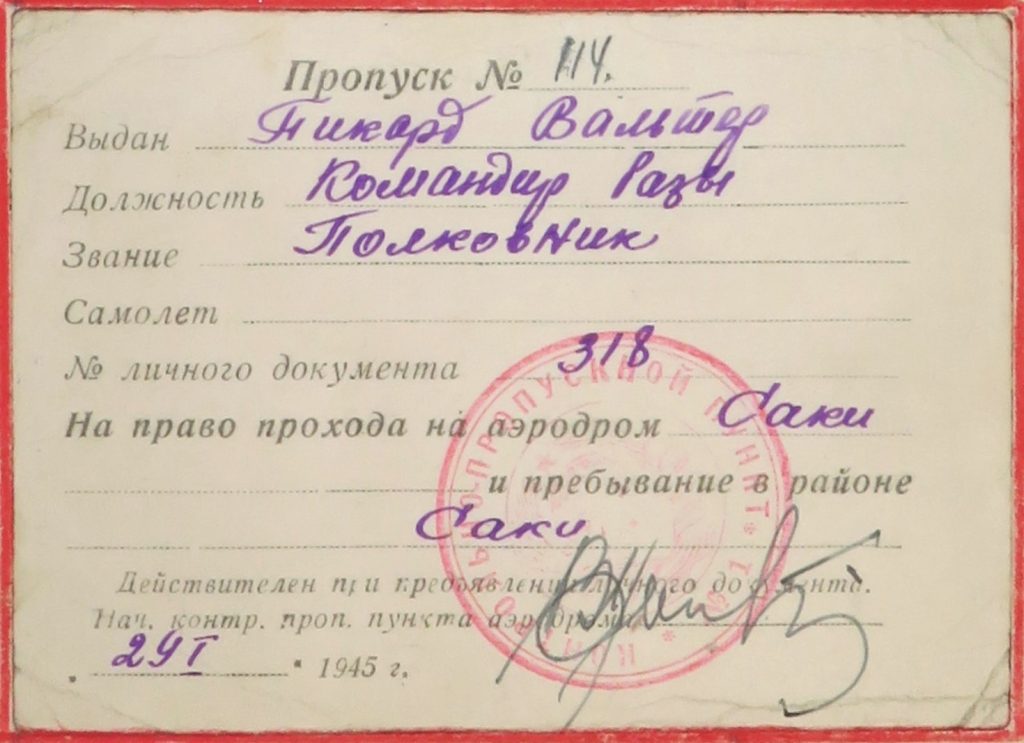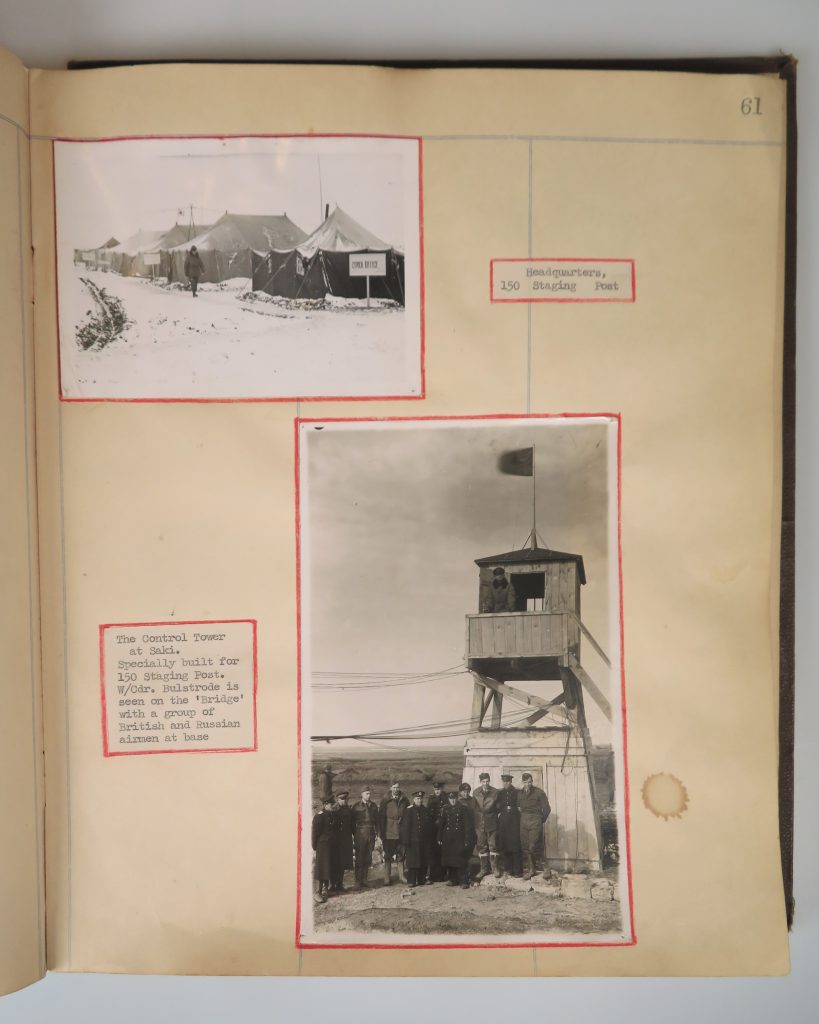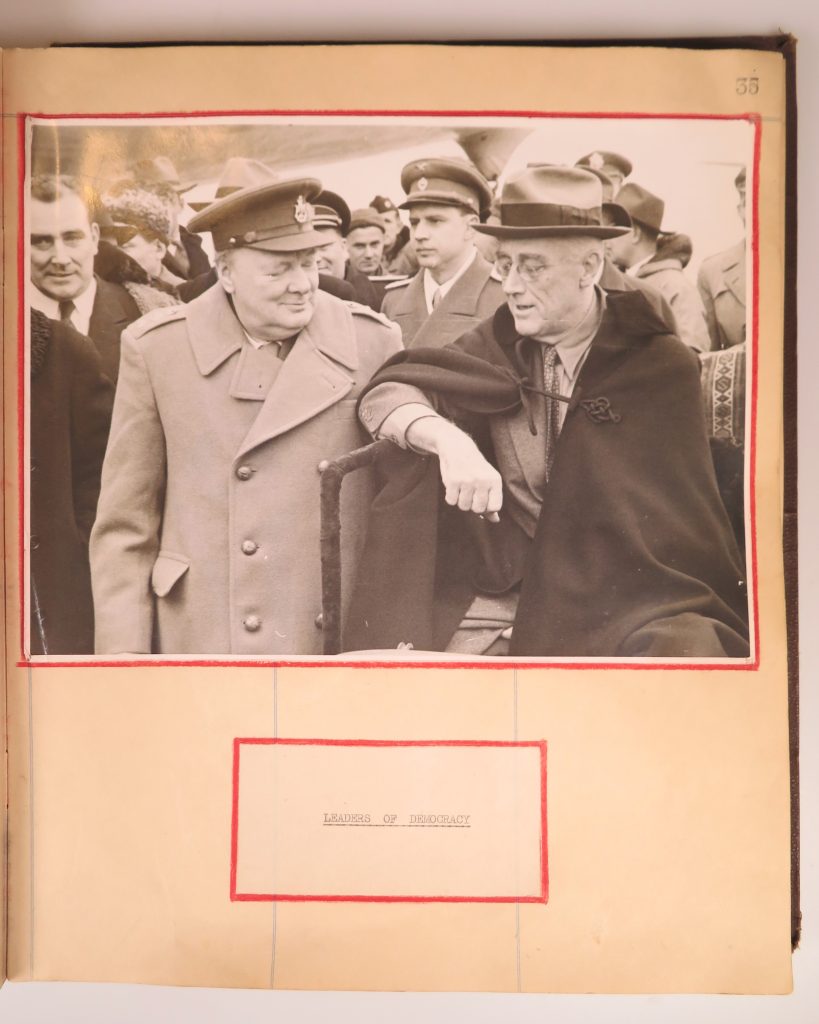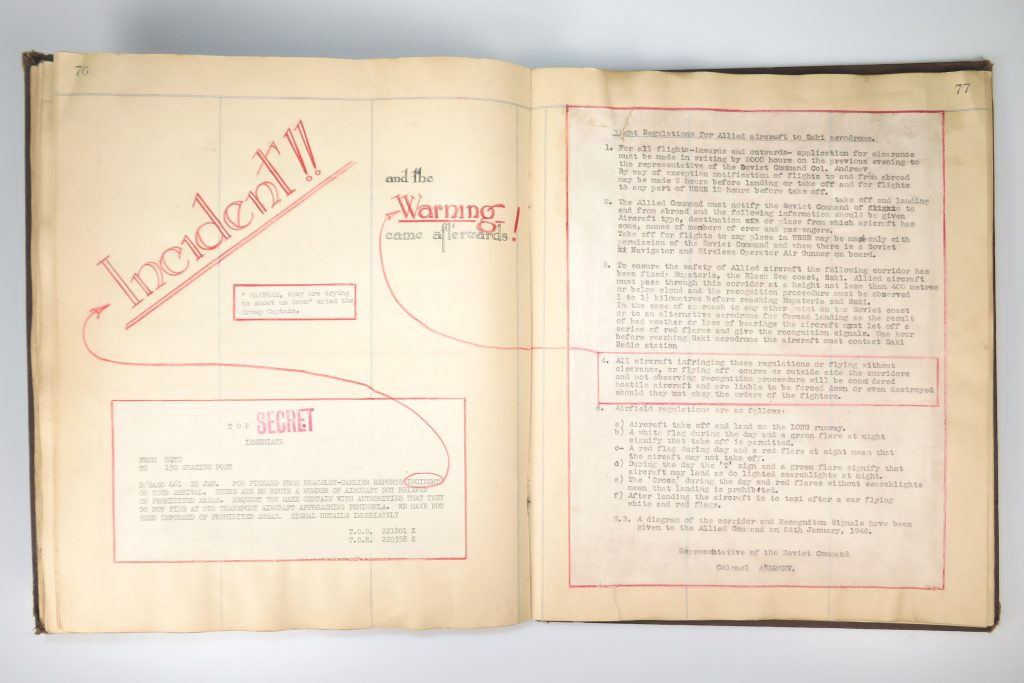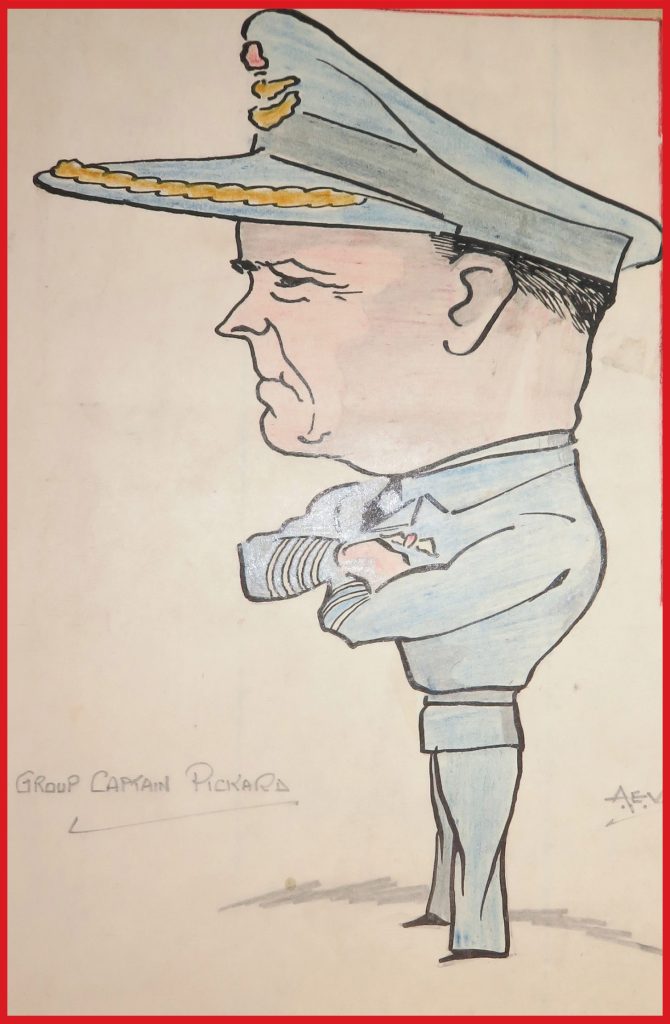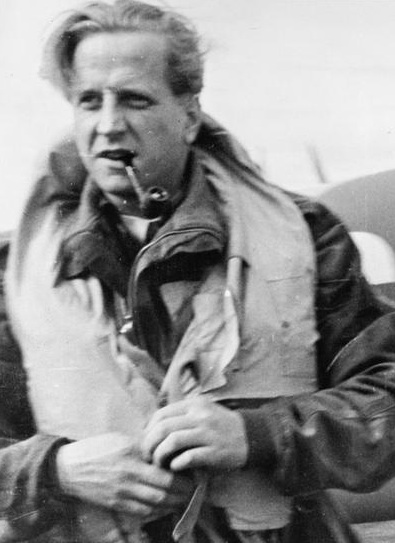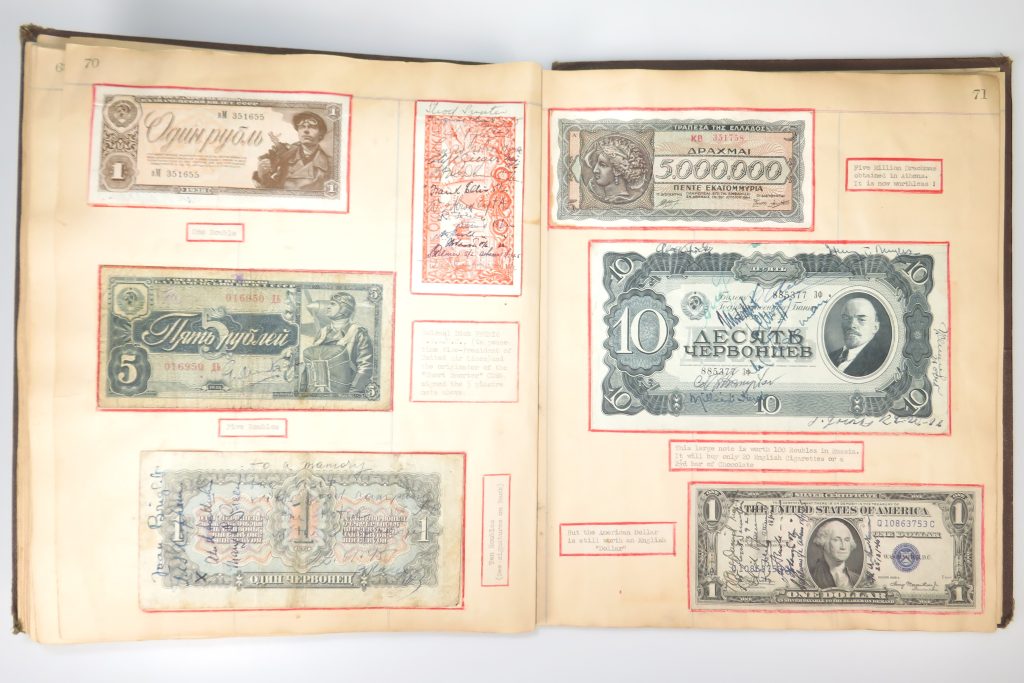Some rarefied and significant material finds our shelves here at Churchill Book Collector, but seldom something both truly singular and so absolutely compelling.
We have just finished researching and preparing to offer a Second World War album. We call it an “album” but the nature and substantive diversity of the contents really render it more of an archive. But “album” we’ll call it for simplicity’s sake, and respecting the fact that it is contained between two covers.
Between the covers are found meticulously captioned photographs and mementos of an R.A.F. officer’s work flying VIPs during the 1945 Yalta (or, if you prefer, Crimea) Conference, a number of “Secret” documents related to transport to and from the Conference, correspondence and currency signed by dozens of senior military figures and pilots, and, last but certainly not least, the dated inscription of Winston S. Churchill and signed correspondence from Churchill’s private secretary confirming that Churchill personally received, examined, and inscribed this album, and conveying Churchill’s appreciation to the album’s compiler.
Yes, that’s a long sentence, but it still utterly fails to fully encapsulate the treasure trove of material herein.
The fact that the album contains material from and about the Yalta Conference – the final meeting of Churchill, Roosevelt, and Stalin – is of course noteworthy. But what truly sets this album apart is its unique perspective.
The Album, Its Charm, Its Contents
This album was painstakingly compiled, decorated, and annotated by Royal Air Force Group Captain Walter J. Pickard, “the first to arrive and the last to leave the Yalta Conference. Pickard titled his album “The Story of 150 Staging Post and the Airlift to the Yalta Conference February 1945”.
Pickard spent January and February commanding a base in Russia and organizing the air side of the conferences. All British and Americans had to go to him to be dispatched. His album documents the staging, preparation, and flights which conveyed Winston Churchill, as well as other British and American delegates, to the Yalta Conference in 1945, earning Pickard the accolades of his commanders, the appreciation of his Prime Minister, and the Order of the British Empire (O.B.E.).
The album is 100 numbered pages in length, bound in leather-covered boards with a large, hand-labeled title “Saki” affixed diagonally on the front cover. Clearly, the album served its purpose; it was looked at, handled not only by Churchill, but presumably by others over the decades. The boards show wear to extremities and the leather-covered spine is gone. The boards and contents nonetheless remain tenuously connected, the mull and overall binding structure quite fragile but still holding. The binding has done its job of preserving the treasure trove within; the contents are generally clean, only lightly toned with scattered stains and occasional creasing, and appear complete, as originally compiled.
The contents of the album include the following:
- A September 9, 1947 typed letter signed by Winston Churchill’s Private Secretary addressed to Pickard acknowledging that Pickard sent the album to Churchill, expressing Churchill’s thanks, and confirming that Churchill inscribed the album, which was returned with the letter.
- Winston Churchill’s inscription in three lines inked on the album’s front free endpaper recto: “Inscribed by | Winston S. Churchill | 1947”. Below and to the right of Churchill’s signature is that of Air Chief Marshal Sir Frederick William Bowhill, who signed as “C in C. Transport Command.”
- Pickard’s title page executed in elaborate, multi-hued calligraphy: “The Story of 150 Staging Post and the Airlift to the Yalta Conference February 1945.”
- A hand-annotated, color map of Crimea.
- Personnel list of those under the command of Group Captain W. J. Pickard.
- 10 typed pages, marked “SECRET”, comprising Pickard’s detailed “REPORT ON OPERATION ‘ARGONAUT’”, dated “26th February, 1945” and signed by Pickard.
- Five letters of appreciation from senior military commanders, including letters signed by U.S. Brigadier General James S. Stowell and General Lord Hastings Lionel “Pug” Ismay.
- “TOP SECRET CYPHER MESSAGE” of “24th JANUARY” from “150 STAGING POST” to “TRANSPORT COMMAND” that, according to Pickard’s elaborate calligraphy annotation, “nearly stopped the Conference”.
- 50 photographs from the conference, 13 of them featuring Churchill, Roosevelt, or both, the balance featuring a mix of senior figures, including British Foreign Secretary Eden, U.S. Ambassador Harriman, U.S. Army U.S. Fleet Admiral King, Chief of Staff Marshall, Soviet Foreign Secretary Molotov, U.S. Secretary of State Stettinius, British Field Marshal “Jumbo” Wilson, as well as Pickard himself, various senior military and diplomatic figures, and support personnel.
- Seven currency notes, including Soviet, American, and Greek, five of them signed by a bevy of people, including pilots.
- A “TOP SECRET – MOST URGENT” typed “1st February 1945” letter signed by Air Commodore Whitney Straight to Group Captain Pickard conveying the “Flight Plan” and “Passenger Lists”, as well as the fighter escort of P-38s and other details, for the transport of VIPs to the Yalta Conference.
- The “Friday, February 16th, 1945” farewell dinner menu, signed on the blank verso by the members of Pickard’s command.
- Pickard’s original Yalta Conference passes – both British Delegation and Soviet.
- An original, colored, full-length, dated and signed 1945 caricature drawing of “Group Captain Pickard” in uniform, accompanied by a clipping from The Evening News about Pickard and his role at Yalta.
- A contemporary Observer clipping that specifically refers to this, Pickard’s “remarkable autograph book…”
- A “24th January” 1945 typed and hand-annotated “TOP SECRET CYPHER MESSAGE” from Pickard regarding critical communication and transport difficulties preceding the Conference.
“Saki” in bold green and red on the album’s front cover refers to the Crimean airbase, built by the Soviets in the 1930s, that served as the landing point for the aircraft bearing Churchill and Roosevelt to the Conference. The base has remained in operation since, most recently by Russia following the the Russian annexation of Crimea.
Beginning with the title page, the album has the look and feel of both military precision and treasured story book. Annotations and embellishments are both meticulous and multi-hued. Finely ruled colored pencil borders surround nearly every document and photograph. Section titles feature colorful, manifestly careful calligraphy. Myriad captions are typed, affixed, and then bordered in perfectly linear colored pencil. Every item seems quite specifically and intentionally placed in the album. Annotations show both diligence and almost boyish enthusiasm. The net effect of all the colorful flare and military exactitude leaves no doubt that the compiler was a pilot. The album is the adult manifestation of a seasoned commander and pilot recording his actual experience of every lad’s dream to fly, to dare, and to overcome.
Pickard organized his album into five titled sections: Operation Argonaut, detailing the official report of Pickard’s successful mission; Appreciations, containing typed signed letters congratulating Pickard on his mission; This Signal Nearly Stopped the Conference, showcasing a top secret message from Pickard expressing concern over the signal equipment functionality and the highly dangerous flying conditions between Saki and Yalta, the latter of which almost caused Pickard to crash on his first attempt; Some Actual Kodak Impressions, photographs of the staging post in Saki, members of Pickard’s squadron, and of Churchill and Roosevelt. Pickard loosely organized the remaining content by theme, such as two pages of signed short snorters, top secret cypher messages, Pickard’s original British and Soviet Yalta passes, and newspaper clippings about Pickard.
The Yalta Conference
In early February 1945, British Prime Minister Winston S. Churchill, U.S. President Franklin D. Roosevelt, and Soviet Premier Josef Stalin met at the Yalta conference in Crimea. The meeting turned out to be their last; 1945 witnessed the final months of the war in Europe, of FDR’s life, and of Churchill’s wartime premiership.
The Yalta Conference, also known as The Crimea Conference, was held at the Livadia Palace near Yalta in the Crimea from 4-11 February 1945. This conference proved a geopolitically defining event of the 20th Century, fundamentally shaping the postwar world and drawing the battle lines of the long Cold War to come. A conventional perspective is that Roosevelt – terminally ill and trusting – viewed massive concessions to Stalin as a hopeful path to lasting peace. By contrast, Churchill deeply distrusted Stalin’s character and motivations, but had little power to resist the tide of Roosevelt’s rash concessions and groundless optimism.
Several images in this album seem to visually assert this interpretation; they feature a sickly and thin FDR, draped in a black cape and seated in an open car, including one in which Churchill stands beside FDR as the latter speaks, both men’s heads turned toward one another, but with the serious countenance of each man facing down into the space between them.
Perhaps better informing this simplified characterization of Yalta, “The central, ever-present fact lying behind everything was that Stalin had an army of more than six million men in eastern Europe, including by then in every region of Poland. The Western Allies thought they needed Russia to declare war against Japan once the German war was over, as they could not be certain that the atomic bomb – which for obvious reasons was not mentioned – actually worked.”
Another constraining imperative was that “Churchill and Roosevelt wanted the Russians to engage meaningfully in the United Nations”. In sum, “There was idealism at Yalta as well as Realpolitik, but there was also lethal decision-making” and, for better and worse, the “Big Three… remade the world in eight days”. There continue to be many ways to regard the competing imperatives and unsavory compromises of Yalta. One might choose to draw inferences from the fact that, “on the 11th Churchill suddenly decided, while giving no reason, that he wanted to leave… immediately, despite being scheduled to leave the next day. He gave his secretarial and household staff only one hour to pack everything up and be off”. (Roberts, Walking With Destiny, pp.859-863)
“They Are Trying To Shoot Us Down”
In order for there to be a conference, the participants first had to get there. Hence his album, Group Captain Pickard, and the Wing Commanders, Squadron Leaders, and Flight Lieutenants under his command. Air transport to the Conference was both a major logistical undertaking and deadly serious business.
Documents in Pickard’s album testify that, under his command, Operation “Argonaut” was tasked with providing “Staging Post facilities at Saki in the Crimea, for aircraft conveying British and American delegates for the three power conference at Yalta”. This effort involved 252 aircraft of at least nine different types – 120 of the aircraft British and 132 American. Additionally, fighter escorts were provided “to accompany the Prime Minister and the Foreign Secretary’s aircraft between Malta/Saki and Saki/Athens.” Obstacles chronicled included severe weather and heavy snowfall, mechanical challenges that saw engine repairs to both Churchill’s and Roosevelt’s aircraft, and communications.
Apparently, there was also the risk of friendly fire. Included in Pickard’s album are the “Flight Regulations for Allied aircraft to Saki aerodrome” supplied by the Soviet Command. Beside this document, in his album Pickard chronicled an “Incident!!” and outlined section 4 of the Regulations in red: “All aircraft infringing these regulations or flying without clearance, or flying off course or outside the corridors and not observing recognition procedures will be considered hostile aircraft and are liable to be forced down or even destroyed should they not obey the orders of the fighters.” According to the album, Pickard’s and other Allied aircraft came close to being shot down by Russian fighters. ‘“HARPHAM [Wing Commander T. A. S. Harpham], they are trying to shoot us down” cried the Group Captain.’” Prior to arrival at Saki airbase, Pickard and his command were not apprised of “prohibited areas” and his aircraft were engaged by Russian fighters. As Pickard notes in his album, “the warning came afterwards!”
In the words of a 25 February 1945 Air Ministry letter in this album marked “SECRET”, “The establishment of this Staging Post under what were clearly very difficult conditions in a place where, in spite of the goodwill of the Russians, facilities were limited and the climate severe, the satisfactory handling of the difficult administrative problems which are always met when operating in Russia, and the reception and dispatch without mishap of a very large number of aircraft both British and American constitute a feat of which your Command may justly feel proud, and which reflect the greatest credit on Group Captain Pickard and those serving under him at Saki.”
Group Captain Walter J. Pickard
Forty years old at the time of his Saki Command, Walter J. Pickard (b. 1905) was married and had an eight-year-old son. Pickard was “tall, fair, with a quiet persistence of character and a keen sense of humour.” He had first joined the R.A.F. in 1925 and served for five years. In 1930, Pickard began working for the “’Ye Mecca’” company, “whose cafes provide the City [of London] with no inconsiderable part of its refreshment needs.” Pickard rose to become an assistant managing director before the Second World War began. On the outbreak of the Second World War, Pickard became a flying instructor at the first R.A.F. school in Canada. Thereafter, he returned to head the Lyneham, Wiltshire, R.A.F. Transport Command Station, where he served until being tasked with the most important of his war tasks – organizing air transport to and from the Yalta Conference, including enhancing and commanding the staging post in Saki on the Crimea peninsula, through which were conveyed British and American leaders, delegates, and staff to the Yalta conference. For this service, Pickard received numerous accolades – many recorded in this album and including the gratitude of his Prime Minister – and was awarded an OBE, becoming an Officer of the Most Excellent Order of the British Empire. Like so many others, after the war, “he [returned] to the business life which he led before the war.”
It Runs in the Family
Walter Pickard’s sister was Lady Hardwicke (Helena Pickard, 1900-1959), the wife of Sir Cedric Hardwicke, both of them stage and screen actors. But the strongest thread in Pickard’s family was flight. Walter Pickard’s brother, celebrated bomber pilot Percy Charles “Pick” Pickard (1915-1944), was the first R.A.F. officer to be awarded the DSO three times during the war. He was known for his role in the 1941 R.A.F. documentary film Target for To-night, as the pilot of the bomber “F is for Freddie”. He was less fortunate in his off-screen fame; Percy Pickard was the commander of Operation Jericho, intended to liberate French Resistance fighters held in Amiens prison, located in occupied France – an operation which claimed his life.
After his film appearance made him a public figure in England, Percy focused on real, off-screen heroics; he flew paratroopers to the Bruneval Raid and commanded the squadron that flew SOE agents in and out of occupied France. His luck ran out on 18 February 1944, while he was leading a group of de Havilland Mosquito bombers on a raid of the Amiens prison to destroy the walls, freeing the prisoners inside, some of whom were reportedly scheduled for execution the next day.
It was a notably daring raid, planned for midday when the guards were taking their lunch. The pilots had the unwieldy task of blowing holes through the prison walls, leaving an escape route. The mission was conspicuously risky for both the pilots and prisoners. The pilots flew so low that their bomber wings skimmed the treetops lining the road to the prison.
Operation Jericho was ultimately successful, measured by its intentions to free those held captive by means of penetrating the prison walls. A number of prisoners were killed by the bombing, but hundreds escaped. Moreover, Resistance members who escaped were able to expose a large number of Gestapo agents and informers. Unfortunately for Pickard, his Mosquito was engaged by a German Focke-Wolf 190 fighter and his aircraft’s tail was shot off. Both he and his navigator, Alan Boadley, died in the ensuing crash. The two had flown more than 100 sorties together over four and a half years. The raid was sufficiently secret that Percy Pickard was not formally announced as killed in action until September 1944, only months before his brother, Walter, would take command at Saki.
So Many Signatures
Amid the wealth of correspondence, documents, mementos, images, and ephemera in this album, it is easy to overlook that it is positively riddled with signatures.
Of course, the standout signature in the album is that of Winston S. Churchill (1874-1965), perhaps the preeminent statesman of his age, whose political career lasted two-thirds of a century, saw him occupy Cabinet office during each of the first six decades of the twentieth century and serve twice as Prime Minister of Great Britain (1940-1945 and 1951-1955), and who became synonymous with Britain’s celebrated perseverance during the Second World War.
On the same page as Churchill’s dated inscription, below and to the right, is the signature of Air Chief Marshal Sir Frederick William Bowhill (1880-1960), whose last R.A.F. assignment was Commander-in-Chief Air Transport Command
Identified autograph signatures on correspondence include those of:
Nina Edith “Jo” Sturdee, later Countess of Onslow (1922-2006), “one of the most significant of Churchill’s personal secretaries… served Churchill during the war years of 1942 to 1945, after which she became his main personal secretary from 1945 to 1953.”
The Album’s compiler, Group Captain Walter J. Pickard, in his role Commanding No. 150 Staging Post, R.A.F. Transport Command
U.S. Army Brigadier General James S. Stowell (1900-1978), then Commanding General North African Division, Air Transport Command, later a Major-General in the U.S. Air Force
General Lord Hastings Lionel “Pug” Ismay, 1st Baron Ismay (1887-1965), wartime Chief of the Imperial General Staff, Chairman of the Chiefs of Staff Committee, professional head of the army, and Churchill’s foremost wartime military advisor.
Air Marshal Sir Francis Joseph Fressanges (1902-1975), then serving as Air Officer commanding 47 Group, and who would eventually rise to Assistant Chief of the Air Staff.
Air Commodore Whitney Willard Straight (1912-1979), who would later become Managing Director and CEO of British Overseas Airways Corporation and Deputy Chairman of Rolls-Royce.
Identified signatures on the verso of the 16 February 1945 Farewell Dinner menu for Pickard’s staff include:
Wing Commander R. F. Bulstrode, Flight Lieutenant W. C. Painter, Squadron Leader D. Shehan, Flying Officer W. C. Over, Squadron Leader A. Leitch, Flying Officer H. G. Melors, S. Baxter, Flying Officer W. Rose, Flight Lieutenant A. R. Matheson, and Squadron Leader E. W. Minto.
A short word on Short Snorters. There are five signed banknotes in the album – “Short Snorters” in the parlance of the time. A Short Snorter was a banknote signed by people with whom you were flying. The tradition was allegedly started by Alaska bush pilots. However it may have begun, it certainly spread widely through military and commercial aviation, becoming particularly prevalent in military circles during the Second World War. “Snort” is derived from the slang for a stiff drink and “Short” is less than a full glass. During the Second World War, Short Snorters became a record of those with whom you’d served and also a drinking game and status symbol. If you could not produce your short snorter on request, you owed a drink. Eventually the signatures sought by pilots on Short Snorters became those of V.I.P.s, not just fellow flyers and colleagues.
This album includes five Short Snorters, on Roubles (1, 5, and 10 denominations), a “5 Piastre note”, and a U.S. Dollar (Series 1935 A), together featuring dozens of signatures, many of which we cannot readily decipher or identify, as well as various annotations, dates, and inscriptions. Among these dozens of names, a number are identifiable as United States Army Air Force personnel with ranks as high as Colonel. Many appear to be R.A.F. officers of various ranks. Intriguingly, there are also a scattering of female names – a “Millicent”, a “Joan”, and a “May” among them. There are also several 1945 dates, and a few place names (“Athens” repeated among them). Intriguingly, at the head of a number of signatures on two of the bills (The “5 Piastre note” and the U.S. Dollar) is the same inscription and apparent claim by one signer, a Col. Dick Phenig U.S.A.A.F. The inscription on both notes reads: “Short Snorter | original [indecipherable] 8-45 | started 1927 | Dick Phenig”. This claim that “Colonel Dick Phenig U.S.A.T.C (in peace-time Vice-President of United Air Lines)” is “the originator of the Short Snorter Club” is stated in one of Pickard’s typed captions.
Still More to Discover…
We have had the privilege of spending quite some time examining this artifact and sussing some of its history, doubtless there is more to discover. We look forward to placing it with a new owner who will continue to explore and preserve the story preserved in this album.
Cheers!
Churchill Book Collector
